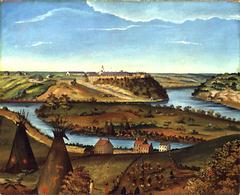Curriculum Materials: Art in America
|
|
Image 7 Edward K. Thomas Questions: |
Look Questions Teacher Answer Key
1. Where was Thomas standing when he sketched or painted this scene? (On a hill looking down.) What makes you think so? Explain that artists often made sketches but then completed their paintings indoors.
2. The title of this painting is View of Fort Snelling. Where is Fort Snelling in this picture? (In the BACKGROUND.) Is the fort the most important part of the painting? Why or why not? Did you notice the fort first when you looked at the painting? If not, what did you notice first? What drew you to that part?
3. The artist organized the painting into three distinct sections-a FOREGROUND, MIDDLEGROUND, and BACKGROUND. What did he include in the foreground? (Tepees, trees and foliage, American Indians who are dancing, sitting, and walking around, a few brick buildings at the bottom of the hill.) What do you see in the middleground? (Water, the confluence of two rivers, two canoes, an island with more tepees.) What is in the background? (Fort Snelling, other buildings, sky with a few clouds.)
4. What devices does Thomas use to create a sense of depth in this LANDSCAPE painting? (Organization of COMPOSITION into FOREGROUND, MIDDLEGROUND, and BACKGROUND; showing objects in the foreground larger than those further back; use of ATMOSPHERIC PERSPECTIVE.)
5. What time of year do you think it is? (Fall or late summer perhaps.) How can you tell? (Many of the trees have brown leaves, and the grass is a mixture of green and brown.) Does it look as if it is warm or cold out? What clues suggest this to you? (The Native Americans who are not dancing are wrapped in blankets; the smoke rising from the tepees may suggest the temperature was cool.)
6. This painting records a site in Minnesota territory at which European Americans and Native Americans came into contact and conflict. Where do you see Native Americans? (FOREGROUND and probably in the canoes.) What are they doing? (Dancing around a pole with scalps hanging from it, sitting, walking, canoeing.) Do you see European Americans in the picture? (No.) What aspects of the picture indicate their presence? (The fort, the other architecture, the U.S. flag.)
7. The term
NATURALISTIC
describes art in which the subject is depicted as closely as
possible to the way it is seen by the human eye. What looks
naturalistic about Thomas's View of Fort
Snelling? What aspects of the painting do not look
naturalistic? Overall, would you describe the painting as
naturalistic? Why or why not? (Although the subject and
objects are recognizable, the scene does not look as it
really would because of Thomas's handling of space and
details, and the lack of
MODELING.)
|
|
